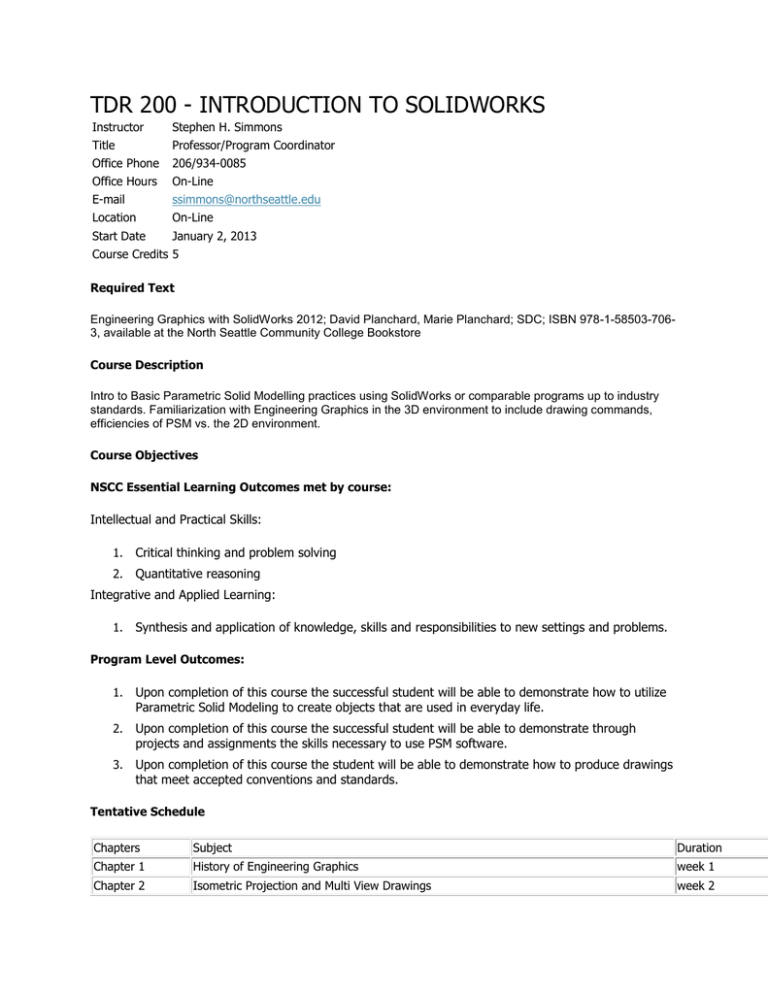TDR 200 - INTRODUCTION TO SOLIDWORKS
advertisement

TDR 200 - INTRODUCTION TO SOLIDWORKS Instructor Stephen H. Simmons Title Professor/Program Coordinator Office Phone 206/934-0085 Office Hours On-Line E-mail ssimmons@northseattle.edu Location On-Line Start Date January 2, 2013 Course Credits 5 Required Text Engineering Graphics with SolidWorks 2012; David Planchard, Marie Planchard; SDC; ISBN 978-1-58503-7063, available at the North Seattle Community College Bookstore Course Description Intro to Basic Parametric Solid Modelling practices using SolidWorks or comparable programs up to industry standards. Familiarization with Engineering Graphics in the 3D environment to include drawing commands, efficiencies of PSM vs. the 2D environment. Course Objectives NSCC Essential Learning Outcomes met by course: Intellectual and Practical Skills: 1. Critical thinking and problem solving 2. Quantitative reasoning Integrative and Applied Learning: 1. Synthesis and application of knowledge, skills and responsibilities to new settings and problems. Program Level Outcomes: 1. Upon completion of this course the successful student will be able to demonstrate how to utilize Parametric Solid Modeling to create objects that are used in everyday life. 2. Upon completion of this course the successful student will be able to demonstrate through projects and assignments the skills necessary to use PSM software. 3. Upon completion of this course the student will be able to demonstrate how to produce drawings that meet accepted conventions and standards. Tentative Schedule Chapters Subject Duration Chapter 1 History of Engineering Graphics week 1 Chapter 2 Isometric Projection and Multi View Drawings week 2 Chapter 3 Dimensioning Practices, Tolerancing and Fasteners week 3 Chapter 4 Introduction to SolidWorks Part Modeling week 4 Chapter 5 Revolved Features week 5 Chapter 6 Swept, Loft and Additional Features weeks 6 & 7 Chapter 7 Assembly Modeling week 8 Chapter 8 Fundamentals of Drawings week 9 Chapter 9 CSWA review - week 10 Final Project delivery week 11 In the last three weeks of the semester, students should start their final project. The project should encompass the following: Project plan Weekly status reports Concept sketches SolidWorks parts, assemblies, drawings and Bill of Materials Cost plan Manufacturing assembly procedure Engineering Change Order/Notice (ECO/ECN) On-Line time is focused on the development and review of manual sketches, conceptual layout sketches, industry scenarios, preliminary designs, modeling techniques and manufacturing concerns. Grading Policy 520.05 The Seattle Community Colleges use a numerical grading system. Passing grades range from 4.0 to 1.0; 0.0 is given for unsatisfactory performance. No grades will be awarded in the range 0.1 - 0.9. Numerical grades may be considered equivalent to letter grades as follows: A 4.0 - 3.9 A- 3.8 - 3.5 Excellent B+ 3.4 - 3.2 B 3.1 - 2.9 High B- 2.8 - 2.5 C+ 2.4 - 2.2 C 2.1 - 1.9 Average C- 1.8 - 1.5 D+ 1.4 - 1.2 D 1.1 - 1.0 Minimum F 0.0 Unsatisfactory Grade-point average (GPA) is determined by dividing total points earned by total credits hours attempted. The following letter grades may also be used: I - Incomplete S - Satisfactory with credit N - Audit NC - No Credit W - Official Withdrawal Y - Ongoing Course 520.10 The student must apply to the registrar for a "W" (an official withdrawal). If application for withdrawal is made by the end of the second week of the quarter, the instructor's signature is not required. No record will appear on the transcript. Withdrawal may be made after that time, up until the end of the eighth week of the quarter (sixth week during the Summer Quarter), after completing an exit interview with the instructor or associate dean. A "W" will show on the transcript. A class withdrawal cannot be made after the eighth/sixth week. After a "W" is issued the course may be repeated only once 520.15 A course may be repeated only once; this may be in order to change a grade, in which case the student must request that the registrar's office use the highest grade in computing the GPA. Otherwise both grades will be averaged in computing the GPA. Permission may occasionally be given for an additional repeat under special circumstances. Approval depends upon the reasons for lack of previous success (such as illness) or by demonstrating reasons to expect future success. Adopted: January 7, 1977 Amended: June 12, 1993 Amended: October 22, 2012 Your course grade will be calculated as follow: In-Class Exams and quizzes 40 % Class Assignments 30 % Help Desk Posts 10 % Final Exam 20 % Total 100 % Attendance Policy Class attendance is very important. Not working more than 5 hours per week on class lectures, assignments, videos, etc. may result in a letter grade penalty. Always try to complete work per the schedule and sign into the Angel website using the provided pin so that your attendance is recorded. Academic Integrity A student who submits the work of another as her/his own or deliberately fails to properly credit words or ideas borrowed from another source is guilty of plagiarism. A student, who uses notes, takes an exam for another student, copies answers from another student’s exam, copies drawings in any manner or any other similar conduct aimed at making false representations with respect to student’s academic performance is guilty of cheating. Please refer to the Student Rights and Responsibilities Handbook for more information regarding academic dishonesty. Disability Policy In my commitment to student learning I want to support all students. If you have a disability that will affect your performance in this class please let me know. Students with disabilities are encouraged to use disability services for support in implementing reasonable accommodations for their disabilities. https://northseattle.edu/disability- services